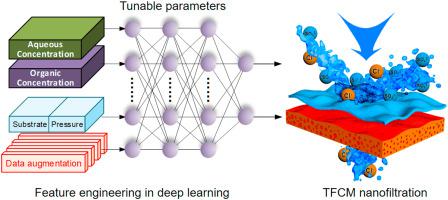当前位置:
X-MOL 学术
›
J. Membr. Sci.
›
论文详情
Our official English website, www.x-mol.net, welcomes your feedback! (Note: you will need to create a separate account there.)
Deep spatial representation learning of polyamide nanofiltration membranes
Journal of Membrane Science ( IF 9.5 ) Pub Date : 2021-02-01 , DOI: 10.1016/j.memsci.2020.118910 Ziyang Zhang , Yingtao Luo , Huawen Peng , Yu Chen , Rong-Zhen Liao , Qiang Zhao
Journal of Membrane Science ( IF 9.5 ) Pub Date : 2021-02-01 , DOI: 10.1016/j.memsci.2020.118910 Ziyang Zhang , Yingtao Luo , Huawen Peng , Yu Chen , Rong-Zhen Liao , Qiang Zhao

|
Abstract Machine learning overfitting caused by data scarcity greatly limits the application of chemical artificial intelligence in membrane materials. As the original data for thin film polyamide nanofiltration membranes is limited, here we propose to extract the natural features of monomer molecular structures and rationally distort them to augment the data availability. This few-shot learning method allows a chemical engineering project to leverage the powerful fit of deep learning without big data at the outset, which is advantageous over traditional machine learning models. The rejection and flux predictions of polyamide nanofiltration membranes are practiced by the molecular augmentation in deep learning. Convergence of loss function indicates that the model is effectively optimized. Correlation coefficients over 0.80 and the mean relative error below 5% prove an accurate prediction of nanofiltration performance. The success of predicting nanofiltration membrane performances is widely instructive for molecule and material science.
中文翻译:

聚酰胺纳滤膜的深度空间表征学习
摘要 数据稀缺导致的机器学习过拟合极大地限制了化学人工智能在膜材料中的应用。由于薄膜聚酰胺纳滤膜的原始数据有限,这里我们建议提取单体分子结构的自然特征并合理地扭曲它们以增加数据可用性。这种少量学习方法允许化学工程项目在一开始就在没有大数据的情况下利用深度学习的强大优势,这优于传统的机器学习模型。聚酰胺纳滤膜的截留率和通量预测是通过深度学习中的分子增强来实现的。损失函数的收敛表明模型得到了有效优化。相关系数大于 0。80 和低于 5% 的平均相对误差证明了纳滤性能的准确预测。预测纳滤膜性能的成功对分子和材料科学具有广泛的指导意义。
更新日期:2021-02-01
中文翻译:

聚酰胺纳滤膜的深度空间表征学习
摘要 数据稀缺导致的机器学习过拟合极大地限制了化学人工智能在膜材料中的应用。由于薄膜聚酰胺纳滤膜的原始数据有限,这里我们建议提取单体分子结构的自然特征并合理地扭曲它们以增加数据可用性。这种少量学习方法允许化学工程项目在一开始就在没有大数据的情况下利用深度学习的强大优势,这优于传统的机器学习模型。聚酰胺纳滤膜的截留率和通量预测是通过深度学习中的分子增强来实现的。损失函数的收敛表明模型得到了有效优化。相关系数大于 0。80 和低于 5% 的平均相对误差证明了纳滤性能的准确预测。预测纳滤膜性能的成功对分子和材料科学具有广泛的指导意义。



























 京公网安备 11010802027423号
京公网安备 11010802027423号